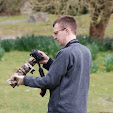+Blashford+Lakes,+Hampshire.JPG)
Full of the joys of spring, a pair of Little Ringed Plover, including this ringed bird, were in front of the hides at
Ibsley Water, digging nesting scrapes, displaying and mating - see images of this fascinating breeding behaviour
here. Between these moments of activity there were long bouts of resting, the birds no doubt still recovering from the exertions of a long migration, and some occasional sparring with passing Lapwing and
Redshank. 9
Goosander (including 2 males)

and a Black-necked Grebe were also present. Rounded the day off with a trip to
Weymouth with the family, catching up with a Spoonbill at Lodmoor and the Alpine Swift at
Radipole Lake in the process, a new bird for Dorset for me. At one point it was chased away from its preferred feeding ground over the roof of
Aldi by a gull, and had to go up-market to feed over the roof of
Matalan instead. Spring 2010 continues to deliver...
 Visitors to Westleton Heath in Suffolk this morning might recognise this view (left) of a grey, red and black smudge sitting on a distant stick. Falco naumanni, to give a grey, red and black smudge it's scientific name, looked more like a swift than a Lesser Kestrel as it sat, sickle-winged, in the gloom. But even in this appalling photo you can see the unmarked back. And despite the mist, rain and limited views, it was still exhilarating to see my first new bird of 2010 - well worth a day's leave. We were very fortunate to arrive at 0800 and see the bird shortly thereafter, as by 0900 it
Visitors to Westleton Heath in Suffolk this morning might recognise this view (left) of a grey, red and black smudge sitting on a distant stick. Falco naumanni, to give a grey, red and black smudge it's scientific name, looked more like a swift than a Lesser Kestrel as it sat, sickle-winged, in the gloom. But even in this appalling photo you can see the unmarked back. And despite the mist, rain and limited views, it was still exhilarating to see my first new bird of 2010 - well worth a day's leave. We were very fortunate to arrive at 0800 and see the bird shortly thereafter, as by 0900 it had gone missing and the rain had set in. By the time it showed again we needed to be on the way home to allow my travelling companion to meet work commitments. Good to see at least one Dartford Warbler had survived winter on the Suffolk heaths, though the Great Grey Shrike (right) nearby might now represent a greater peril than the snow. Anyway, back to my excellent Kestrel photo: if you look closely you can just make out the pale claws...
had gone missing and the rain had set in. By the time it showed again we needed to be on the way home to allow my travelling companion to meet work commitments. Good to see at least one Dartford Warbler had survived winter on the Suffolk heaths, though the Great Grey Shrike (right) nearby might now represent a greater peril than the snow. Anyway, back to my excellent Kestrel photo: if you look closely you can just make out the pale claws...
+Blashford+Lakes,+Hampshire.JPG)

+Burley,+Hampshire.JPG)
+Blashford+Lakes,+Hampshire.JPG)
+Baiter+Park,+Poole.JPG)
+Baiter+Park,+Poole.JPG)
+Rodden+Hive,+Dorset.JPG)

